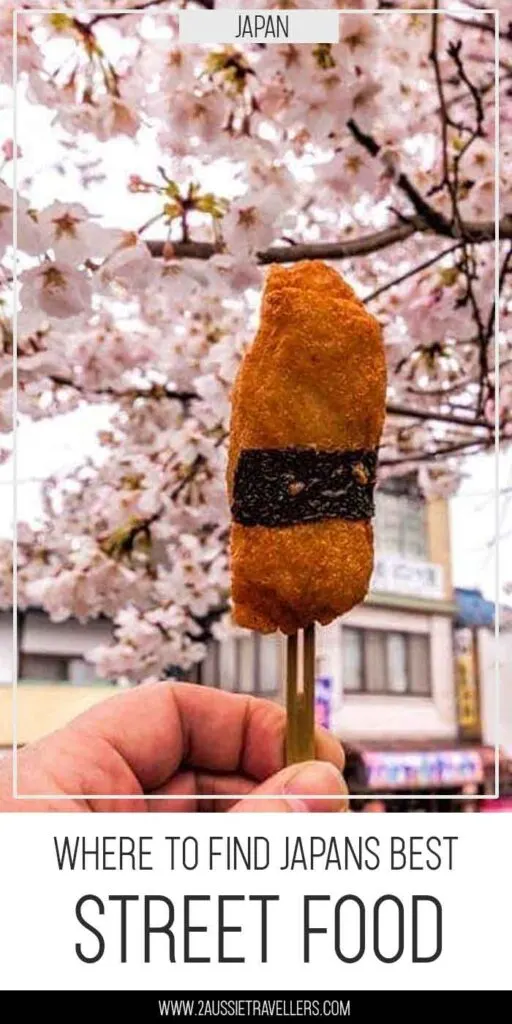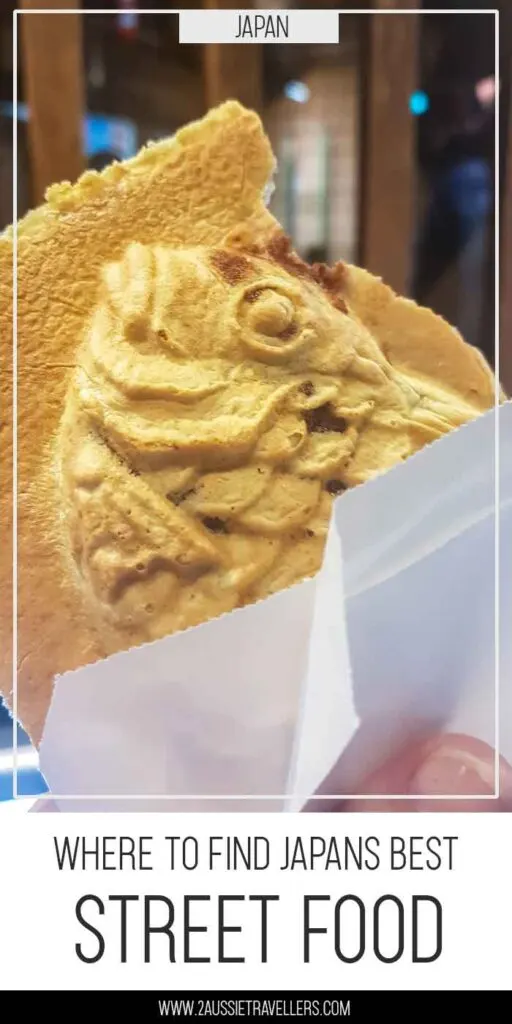While we waited for the borders to reopen to one of our favourite travel destinations I’ve had plenty of time to reflect on street food in Japan and savour some of the wonderfully tasty memories from past visits. We’ve debated what is the best of the best and deliberated over what we will seek out first when we land.
When someone asks about the food they must try in Japan there is a long list of delicacies and painstakingly presented traditional foods that we love. They aren’t the full story though, these street snacks and festival treats are delicious and just as much a part of the everyday culture in Japan. Make sure Japanese street food is on your list too.
Table of Contents
Is it ok to eat street food in Japan?
You might have heard that they don’t have street food in Japan, or that only foreign tourists eat street food. It’s just not true but like anything, there are some cultural norms and etiquette to be aware of.
In Japan, people generally don’t walk around while eating. It’s probably not considered a great look to walk down the road cramming food in your mouth anywhere in the world but it’s less accepted in Japan than in some other places. Having said that, you will still see people walking and eating from time to time.
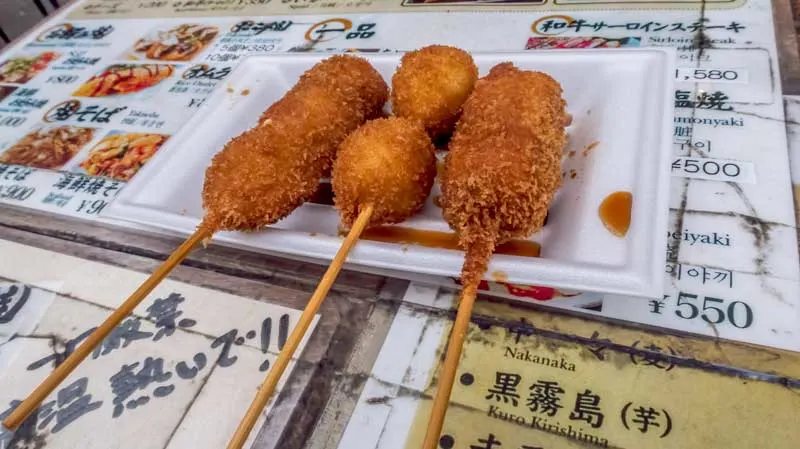
Part of it stems from showing respect and appreciation for the food and those who prepared it. Whatever the reason, when food is good I want to stop, take the time to taste it and enjoy it, it’s more than fuel, it’s part of the experience.
When you buy street food the vendor is likely to provide a few seats or a standing bar where you can enjoy it or people will just stop nearby to eat, especially if there is a park or rest area. The vendor will provide a rubbish bin to dispose of wrappings when you are done as public rubbish bins aren’t common in Japan and you don’t want your bag full of used serviettes and food wrappers.
Where do you find the best Japanese street food?
If you are after something to eat while out and about in Japan then there are a range of things you can pick up in convenience stores and around the train and subway stations that are really good.
For the best street food in Japan, you will often find it at a local festival or a tourist site. Now that seems a bit counter-intuitive but the little shopping streets that lead up to castles and major temples or popular tourist areas like Dotonbori in Osaka are a street food bonanza.
Equally a little kiosk up a mountain, a side of the road grill on the road leading up to a hiking trail, a yatai (food cart) in an old part of town or a window counter where you notice a queue of local mums or Gran’s, that is somewhere we always check out.
15 Fabulous street foods in Japan
1. Senbei
A senbei is a rice cracker, but not as we know it in the west. An artisan-made senbei is crunchy, it’s hearty, filling and packed full of flavour. I have a few favourite Senbei stores around the country but if you spot a shop that specialises in just these delicious rice snacks then it’s probably going to be good.
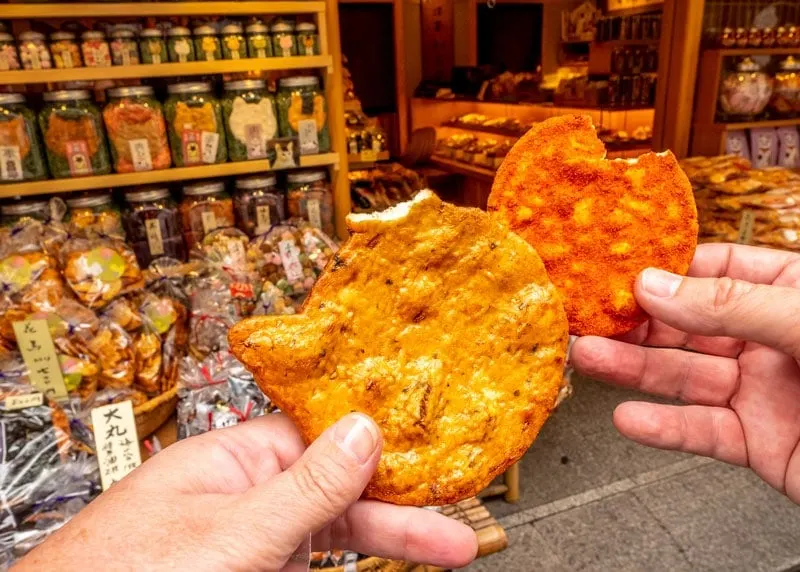
My favourite in Kyoto is the one on Sanjo Dori, next to the Starbucks and the Kamo River. In Tokyo, you want to wander around the back streets of Asakusa and with any luck, you’ll stumble into Izumiya Honten, they really are so good.
I recently had an excellent scallop one in the Sakuraco box of treats and it reminded me just how different a senbei and a rice cracker in Australia really are.
2. Onigiri
In its simplest form onigiri are rice balls but they are often stuffed with a tasty filling. It’s very common to see them formed into a triangle shape but shaped like a patty or cylinder they are still onigiri. These ones are yaki-onigiri, they start off the same but are glazed with sauce and grilled. Delicious.
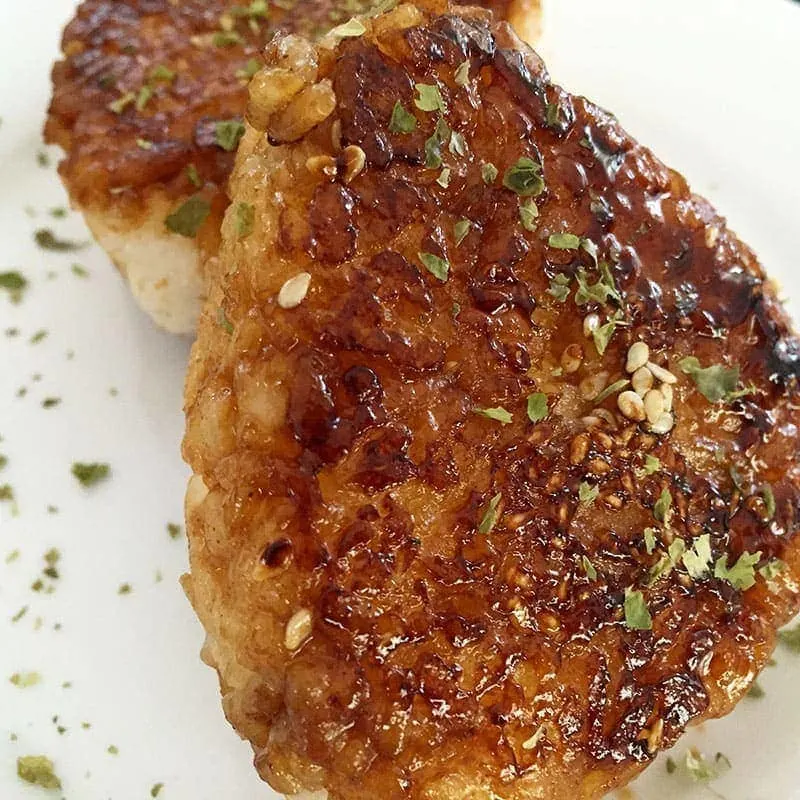
Often onigiri will be wrapped in nori, a dried seaweed sheet. They may be fully encased, others have a small rectangle just enough to keep your fingers clean and others have none at all. The ones you buy in convenience stores have smart packaging that keeps the nori away from the rice until you open it so it doesn’t go soft.
You can even buy those plastic wrappers at Daiso but I have some cute reusable onigiri containers that are perfectly sized for my hand shaped onigiri triangles to keep them protected in the picnic hamper or pack.
If you’ve been to Japan then you probably have a favourite onigiri, they are such an iconic quick snack or meal from the likes of 7-Eleven. Mentaiko or spicy cod roe is one of my favourite fillings but they can be filled with anything from salty umeboshi plums to cooked salmon, seaweed or even natto (fermented soybean).
3. Takoyaki
Takoyaki is grilled balls of batter with octopus (Tako) inside, sometimes it’s best just to try it without the explanation first because I’m quite aware that doesn’t sound great but takoyaki is delicious. This photo was taken on our very first day in Japan outside Yoyogi Park in Shibuya and I was fascinated by how he poured the very liquid batter into the half-sphere grill pans and rotated them with skewers until they were perfect circles.
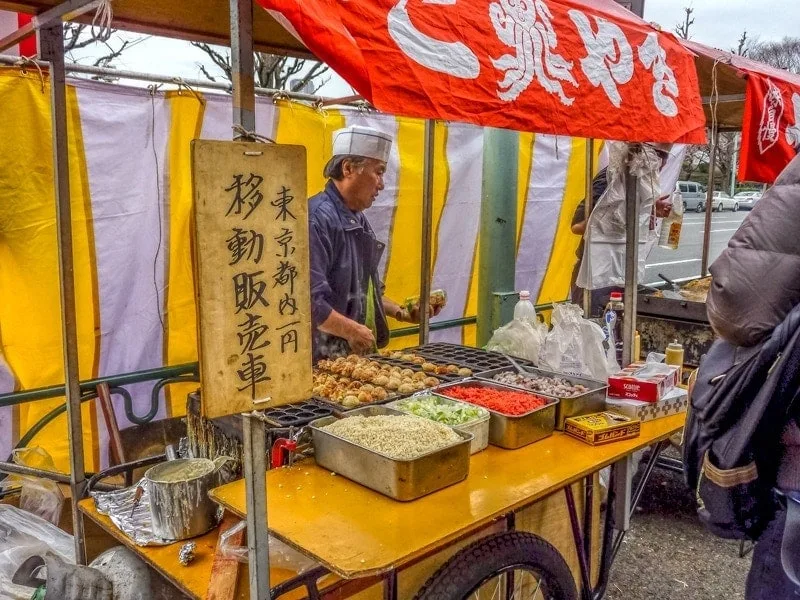
The takoyaki is usually served piping hot and topped with sauce, mayonnaise, bonito flakes, seaweed flakes and sometimes additional items like tempura bubbles and sesame seeds. While the name would imply they always have octopus inside you can sometimes get different fillings such as other seafood, meat, and cheese. In Osaka, home of takoyaki I’ve even seen vegetable options advertised but while the filling might be vegetable be aware that the batter would generally contain egg.
4. Okonomiyaki
Okonomiyaki is another one that is so delicious but hard to explain. Basically it’s a cabbage fritter with additions and toppings to taste. Okonomiyaki translates into something like ‘as you like it, grilled’ and that is pretty much the extent of it. All manner of seafoods, vegetables and meats can be selected and added along with squirts and scatterings of toppings.
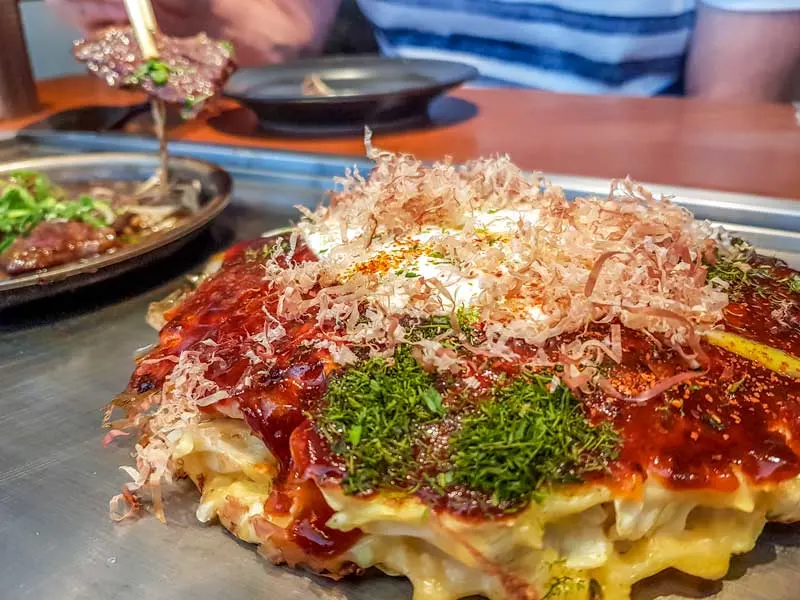
In most places it will be cooked in front of you, as street food generally it’s prepared at a food cart although this photo is at an izakaya in Osaka that specialises in okonomiyaki and has the grill in the table. I love Okonomiyaki as warming and filling street food during cherry blossom viewing. Ueno Park in Tokyo and Maruyama Park in Kyoto are both spots we’ve had good okonomiyaki under the cherry trees.
5. Taiyaki
Translated as ‘grilled sea bream’ this street food treat isn’t fishy at all, it’s a sweet treat. Made in moulds shaped like a fish, the batter forms a crispy wafer like shell around the interior filling. Typically stuffed with sweet red bean paste like this one you can also often find these with green tea and custard fillings.
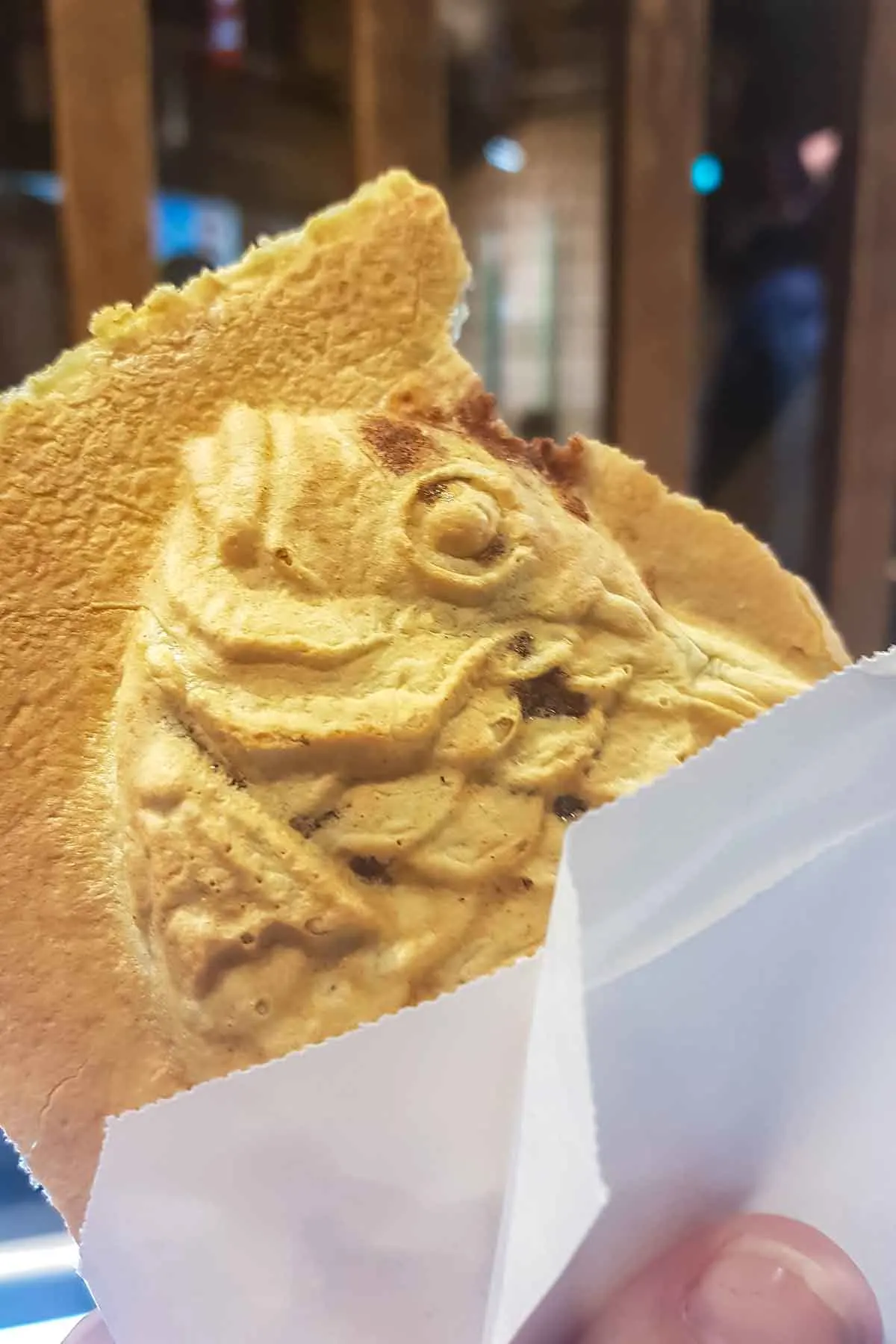
Often the Taiyaki is cut into shape, this one with wings is from Taiyaki Kanda Daruma in Shimbashi and is delicious. The shop is super popular and always has a good queue and fast turnover at the window, especially in the evening as people make their way home and to the train station.
6. Dango
Dango is a Japanese dumpling made from rice flour. It is sweet with a soft, squish and chewy texture, while the ingredients are similar to mochi it’s not made in the same way. This example is Mitarashi Dango, meaning it is coated in a sweet and sticky soy sauce glaze and is my personal favourite.
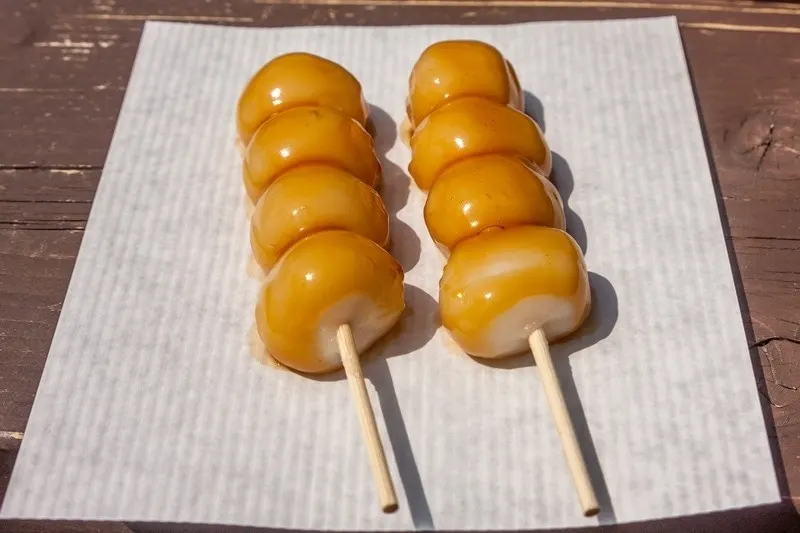
It’s almost always formed into round dumplings and served on skewers but if soy syrup doesn’t appeal there are lots of other finishes to choose from. It can be baked or toasted, flavoured with green tea, red bean or sesame paste. Another popular variant is the pink, white and green dango sold during the cherry blossom season.
7. Karokke
The name comes from the French croquette, effectively a potato patty that may be stuffed with meat and vegetables and then fried until crispy. They are generally sold from open food booths like this around the city, this one in Ueno is really popular and there is an excellent one in Asakusa too.
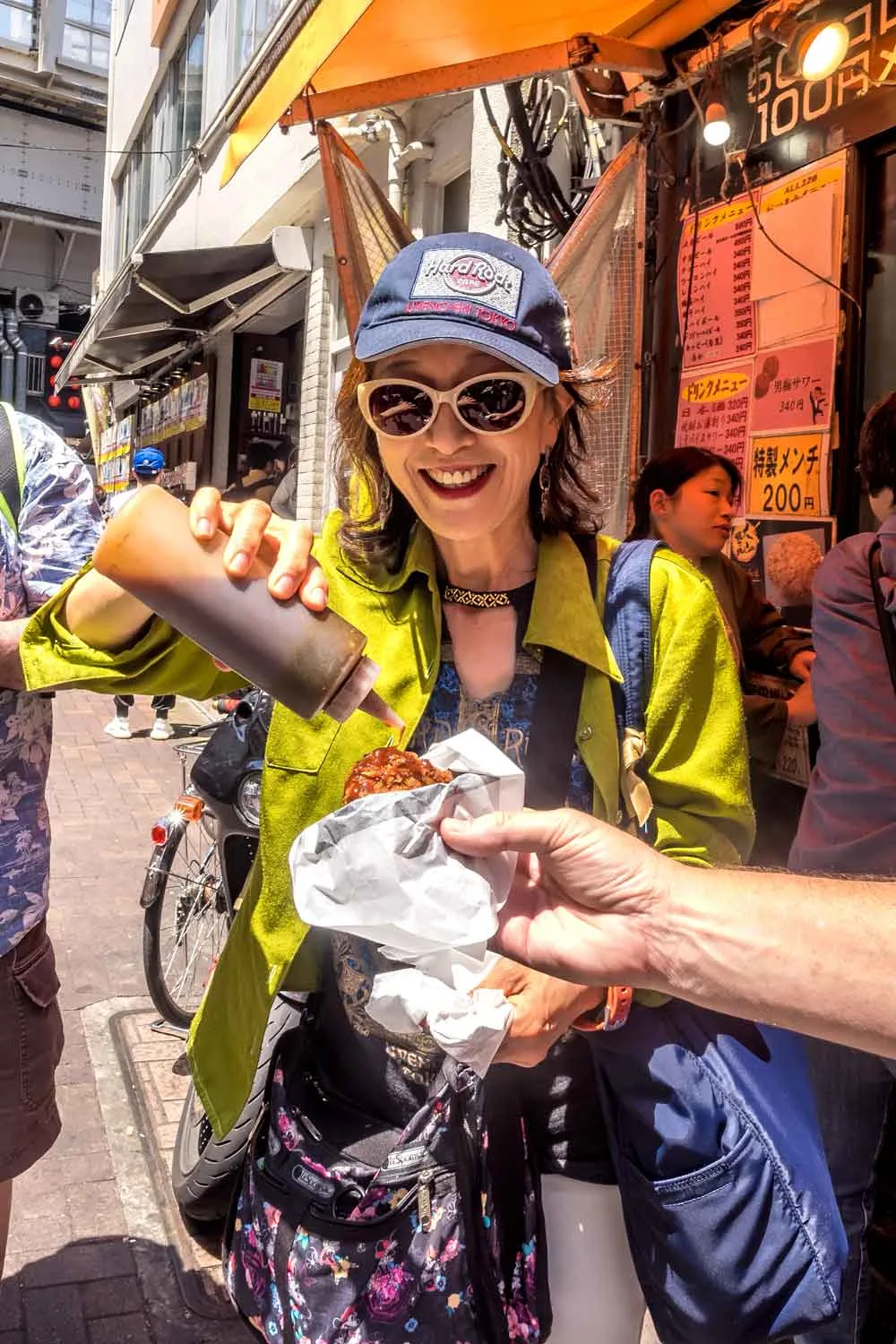
8. Roasted Chestnuts
During fall roasted chestnuts and chestnut flavoured food items are really popular. If you see somewhere with the roaster run along the side of the road and piping hot chestnuts for sale that is the time to try them. We picked up these ones as we walked from the train station up to the Minoo Falls hiking track and sat by the stream to eat them. Freshly roasted they are soft and fluffy and delicious.
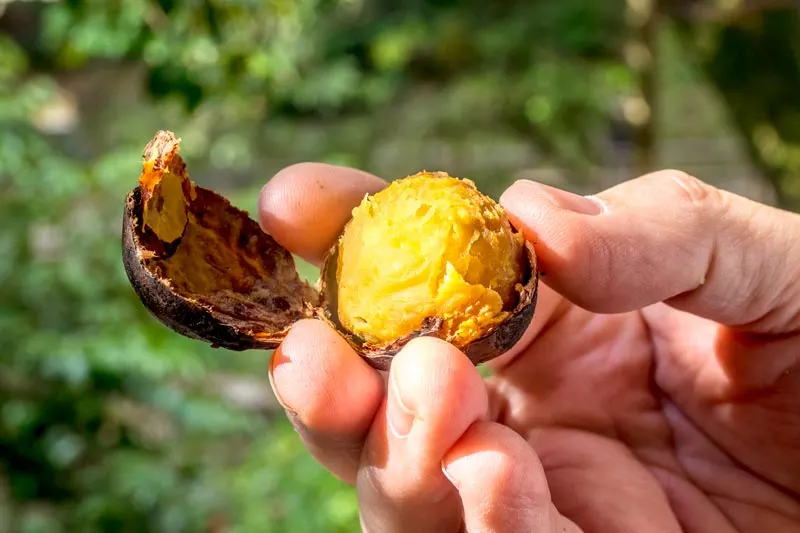
We’ve also bought them fresh from the roaster over on Miyajima Island before doing the Mt Misen peak, again they were beautiful. Sometimes they will be roasted for sale at festivals but we have also bought a bag from a street vendor doing the autumn leaves circuit in Kyoto and were really disappointed to find they were cold and probably not roasted that day.
9. Kushikatsu
Kushikatsu originated in Osaka like many of the Japanese street food options but you will find it in many forms around the country. They are deep-fried skewers of meat, seafood, chicken, cheese or vegetables.
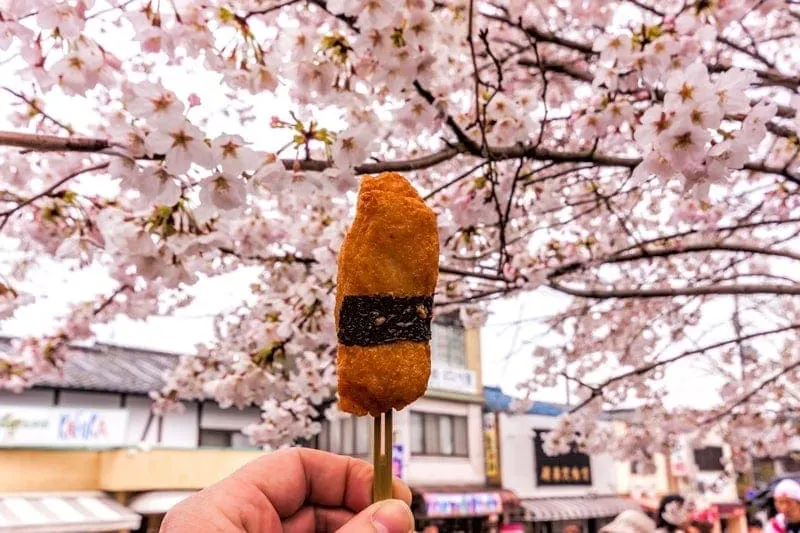
There are restaurants that specialise in these little bites in Osaka but when purchased from street vendors they often have a selection of a dozen different options and you purchase individually whichever takes your fancy.
10. Nikuman
Nikuman are the Japanese version of a steamed port bun although they do come with other fillings at times. In the markets in Hakodate I tried two particularly interesting ones, the first had a black bun coloured with squid ink and the other, technically I guess a kaniman, had a delicate and delicious crab filling in a pillowy soft bun.
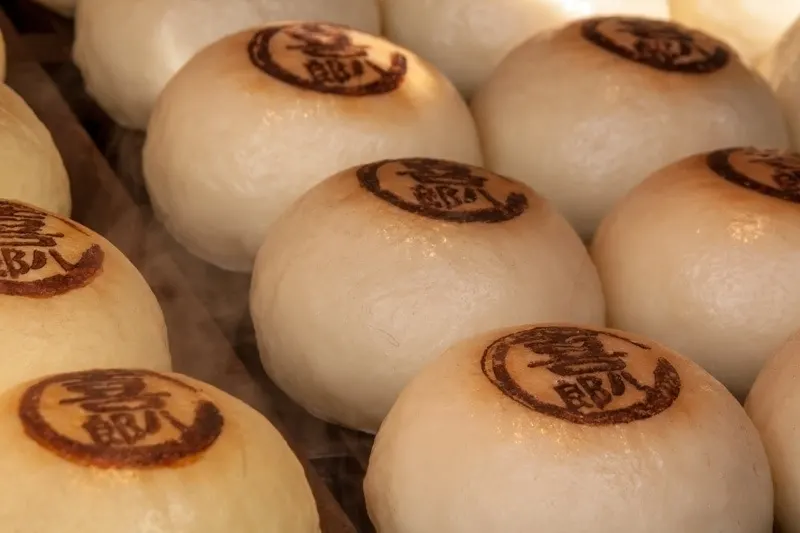
The ones above were tasty roast pork, piping hot from the steamer at a tiny kiosk just down the road from Kiyomizudera in Kyoto. These ones are a consistent favourite as we’ve been there on several trips over the years and have never been disappointed.
11. Melonpan
Melonpan or melon bread contains no melon, the name comes from the crisscrossed top that resembles a popular melon grown in Japan. Inside the bread is faintly sweet, soft and fluffy while the top has a distinctive pattern and biscuit-like crunch.
Some melon pan is average, a bread snack that fills the gap but isn’t so memorable but from the specialty vendors perfecting this treat is their one true calling, when that is the case it is something really special and so much more than it appears.
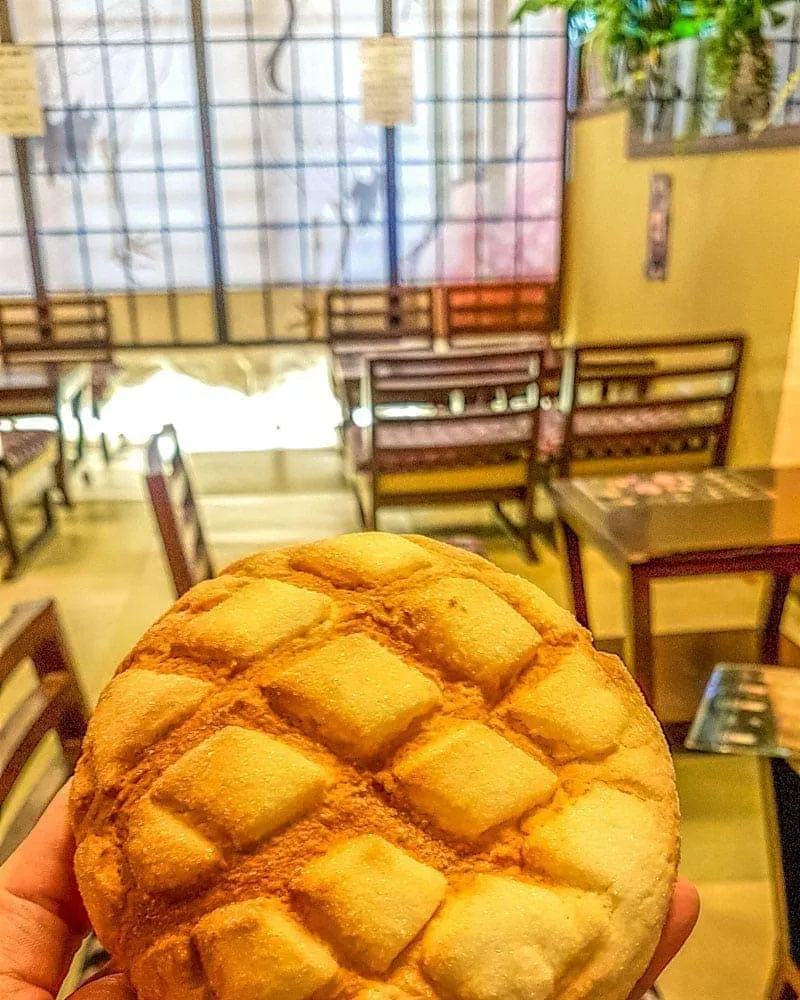
The boutique melon pan bakeries are usually serving windows facing the street with a few ovens behind the counter where they sell it as fast as they can bake it. The one below is Asakusa Kagetsudō and my favourite so far but don’t leave it too late in the day, they close when they sell out. They have a teashop upstairs at this site and you can take your snack upstairs to enjoy it in a quiet space.
To give an idea of how seriously the true aficionados take their melon pan, the owner of Asakusa Kagetsudō majored in fermentation, the secret of great melon pan, at the Tokyo University of Agriculture. He considers it to be a process closer to sake production than bread given the long fermentation (rising) process that involves closely watching the development of the yeast. The exact recipe and timing are tweaked daily to take account of changes in season, humidity, temperature and the batch of flour.
12. Gyoza
Gyoza evolved from ‘pot stickers’ in China, they are delicious to eat and fun to make. Again they are a popular festival food and street food in addition to regularly appearing on the menu of izakaya and restaurants.
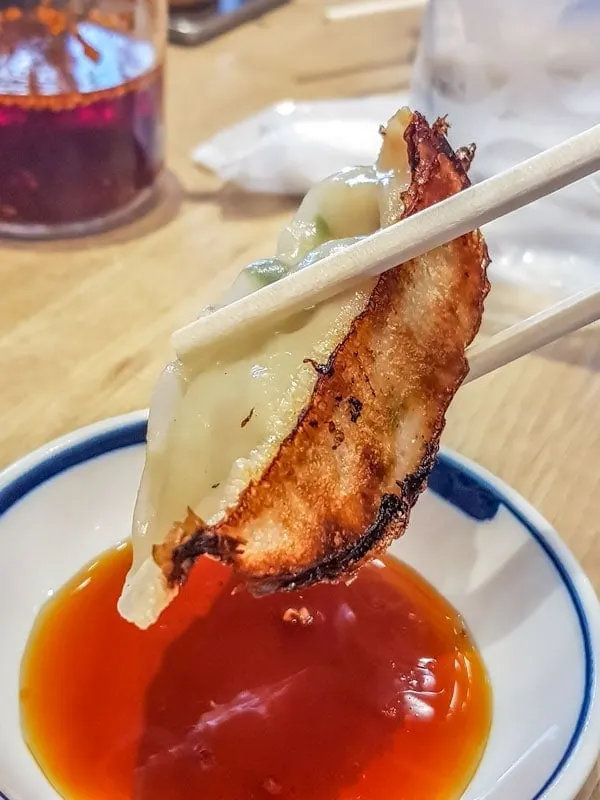
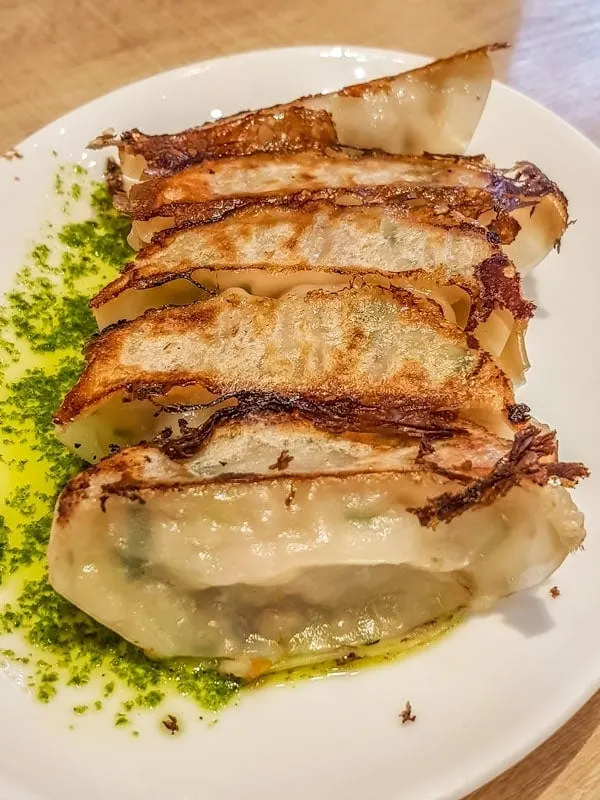
They are a form of dumpling that is fried on one side and then finished by steaming. Most often they are filled with a mix of pork mince, chives and spring onions but all manner of fillings are offered in different places.
12. Momiji Manju
This soft buckwheat and rice confectionery are shaped like a maple leaf and filled with either red bean paste or a fruit flavoured centre. The outer consistency is a bit like a soft cookie.
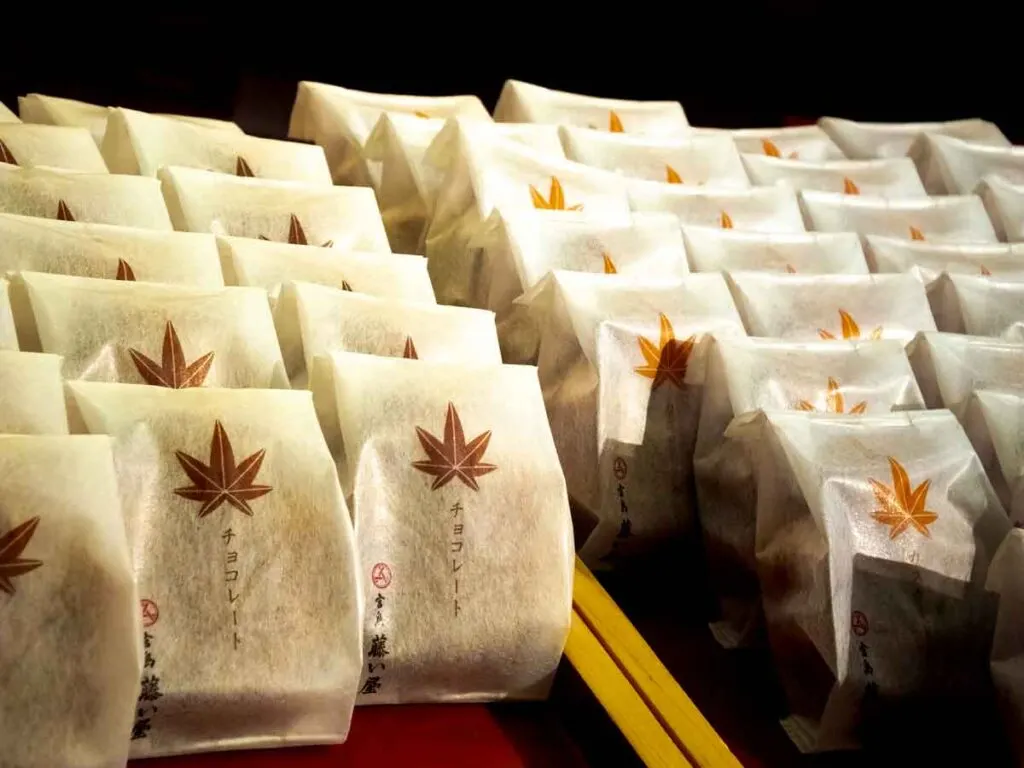
They are sold on Miyajima Island as a snack but Momiji Manju is recognised across Japan as a souvenir from Hiroshima Prefecture and is sold in many souvenir shops to take home and share with friends and colleagues.
14. Toffee fruit and fruit on a stick
In markets and festivals, a common street snack is fruit on a stick and it is one I really enjoy as fresh raw fruit is often what I am craving by the time we leave Japan. Fruit can be very expensive in Japan and the choice in the major tourist areas is often quite limited. If you are in a supermarket in a regional area that is different.
You also sometimes see toffee fruit, especially large strawberries, that are a bit like the toffee apples we had in New Zealand as kids but with a much thinner glaze of toffee so you get the sweet crack without breaking a tooth.
15. Fried maple leaves
Seasons are central to food in Japan and the maple leaves made another street food appearance in the form of tempura coated leaves. These seemed to be a specialty in the Minoo area of Osaka and we must have passed half a dozen different places selling them.
We purchased ours up the top of the trail just before the falls because we have to try a specialty like this but we made the wrong choice and didn’t eat them immediately and let them go cold as we walked down to a seating area by the rapids.
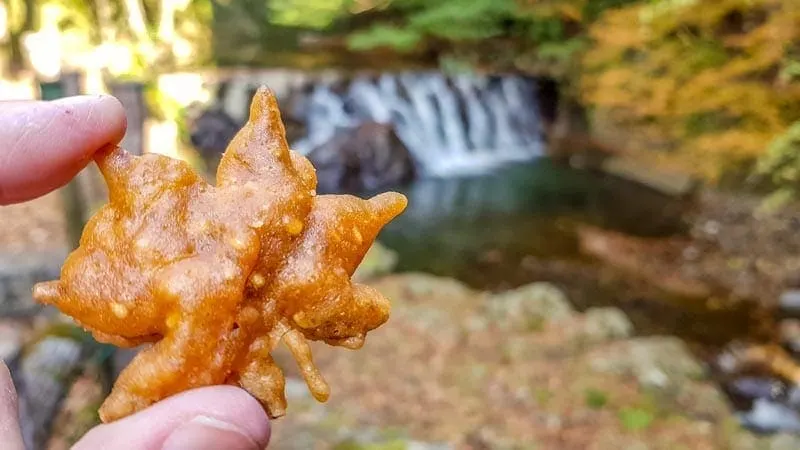
The batter is crunchy and is really what you taste. While young maple leaves are edible either raw or cooked you really taste the batter rather than the leaf in the snack. To be fair I’m not a huge fan of fried food but although they weren’t oily I think these would have been better if eaten while hot but that’s my bad.
16. Soft cream
Hokkaido is known for its milk and dairy generally so when we came across this soft cream kiosk at the Onuma Quasi National Park partway between Hakodate and Sapporo we had to try it. I’d already had sesame and green tea a few times so went with the melon and milk, both produce that Hokkaido is well known for, and it was delicious.
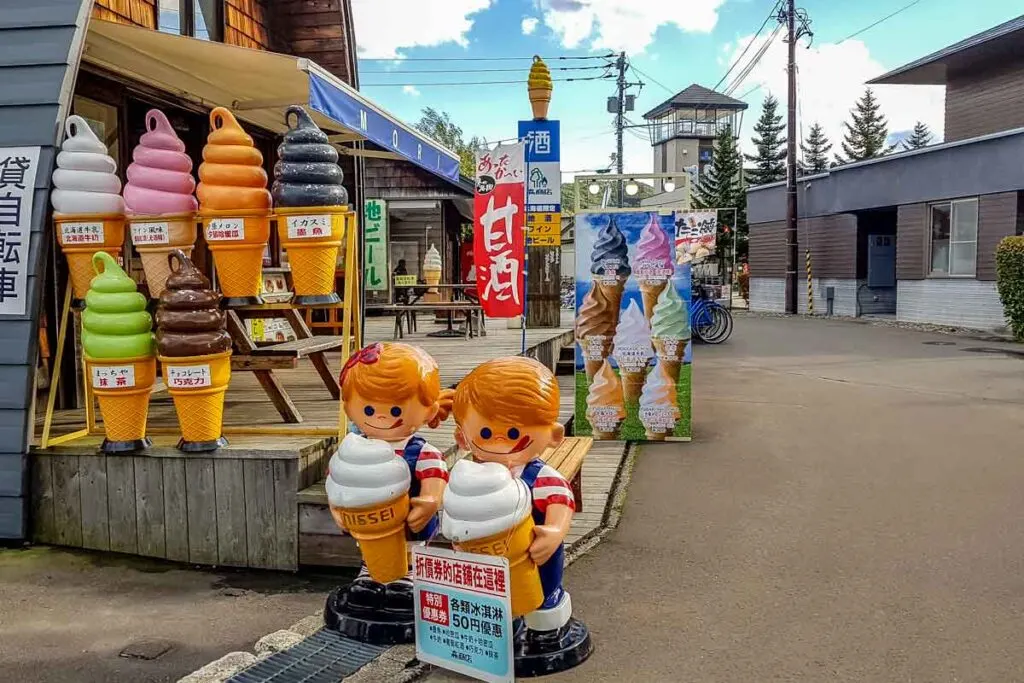
You don’t need to travel as far to try it because delicious soft serve or soft cream as it’s also called is available in both mainstream and unique flavours all across the country. It makes a great afternoon treat to top up your energy levels after a day on your feet.
17. Shu cream
I have to admit to being a massive fan of shu cream in Japan. These Japanese cream puffs are a Japanese interpretation of the profiterole, shu coming from the French ‘choux’ pastry.
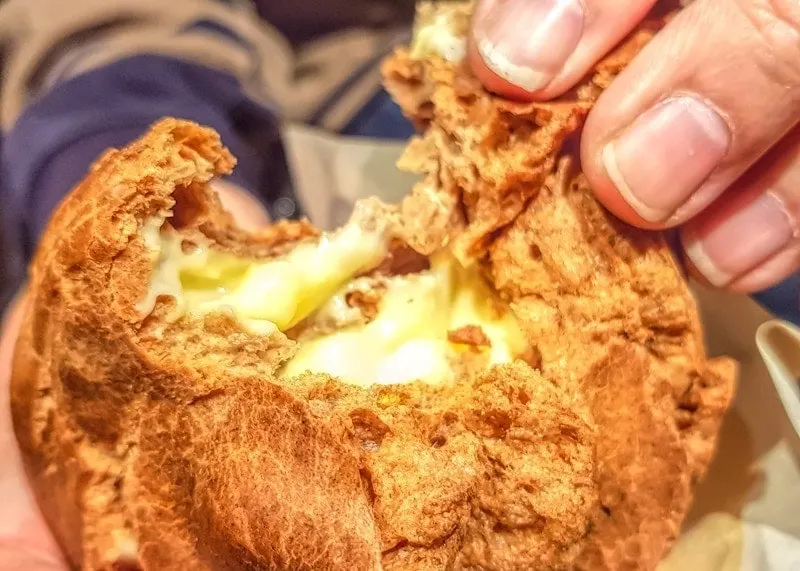
The pastry here is slightly less delicate than your typical eclair but it provides a nice substance to contain what is always a very generous filling of custard or pastry cream. The Japanese filling is super silky smooth, fluid and delicious. Matcha flavour fillings are common along with traditional custard and specialty versions around the seasons like cherry during sakura or chestnut cream in autumn.
18. Hokkaido cheese tart
Another snack item associated with Hokkaido dairy is the cheese tart but they are available all across Japan from small carts and storefronts and from specialty chains in the cities. One interesting thing I’ve not noticed with similar tarts in other cuisines is that in Japan they are offered both hot or cold. The cheese flavour is definitely intensified in the warm version but both are very good.
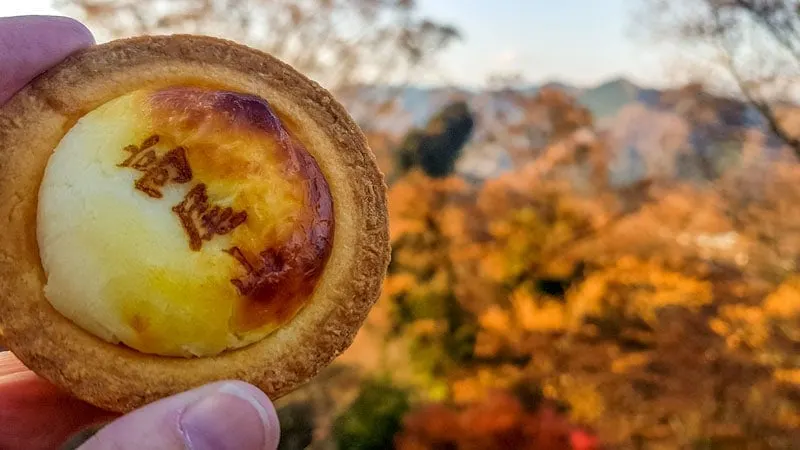
One of the more memorable spots we stopped for one of these was up Mt Takao in Tokyo looking out into the distance over the autumn foliage colour.
19. Shaved ice
Shaved ice is called kakigōri in Japan and because many festivals are held in the summer this is a popular festival food but is also a common snack at parks and other areas where people gather. The finely shaved ice is topped with fruit flavoured syrups and often condensed milk is poured lightly over too.
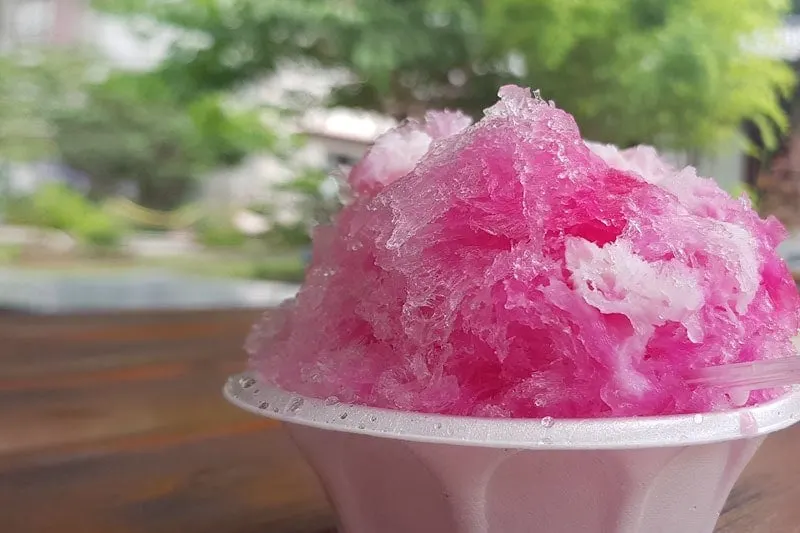
kakigōri originated in the Heian period when blocks of ice were saved in winter and shaved and served to the aristocracy in summer. Many places now use commercial machines to create the ice shavings or even crushed ice but this one in Nikko was made with a traditional hand-turned ice shaving machine and blocks of Nikko spring water.
20. Mochi
Mochi is a sweet made of glutinous rice powder, traditionally made it is pounded until it is soft and elastic then formed into balls or patties. It is served in many different ways, most of them very good but I especially love seeing it toasting over a charcoal brazier as a street food snack.
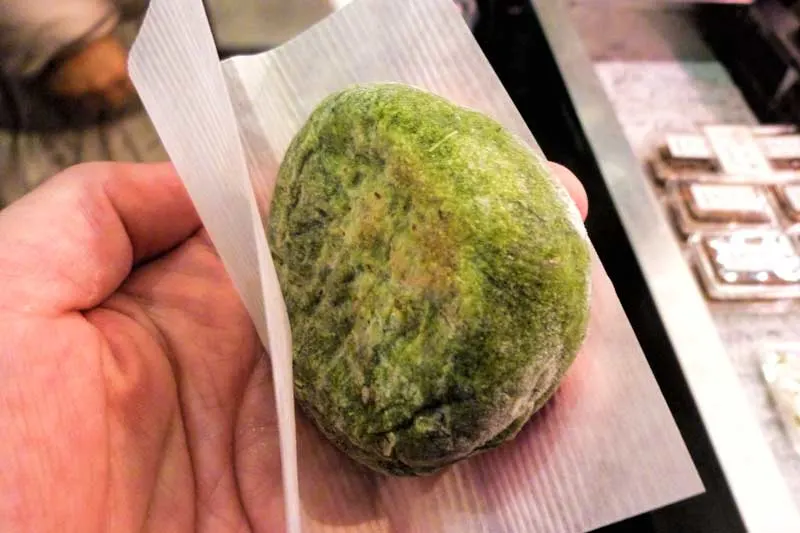
This one is from Nishiki Market in Kyoto where I waited while it was freshly toasted for me making it all melty and delicious inside. I initially thought it was green tea flavoured but eventually discovered it was mugwort, once my tastebuds converted from what they expected to what they got I really enjoyed the earthy herbal flavour.
What is your favourite snack or street food in Japan? Share your favourites or top tips on where to find the best of the best in the comments below.
If you found this article useful please consider saving it to Pinterest. It makes it easy for you to find it again, it helps us, and it helps other travellers to find the information they are looking for.
